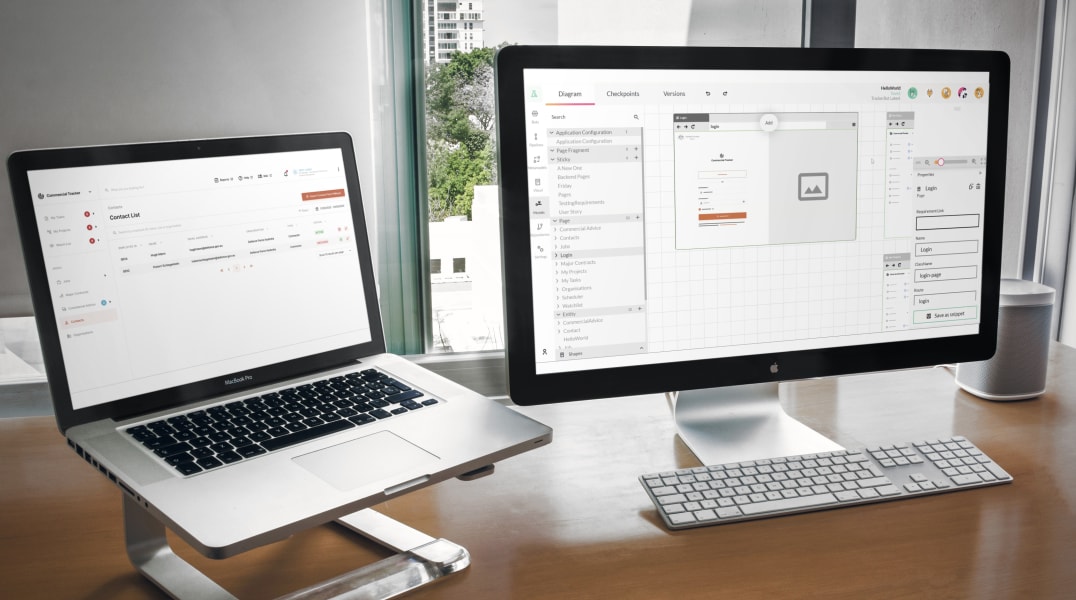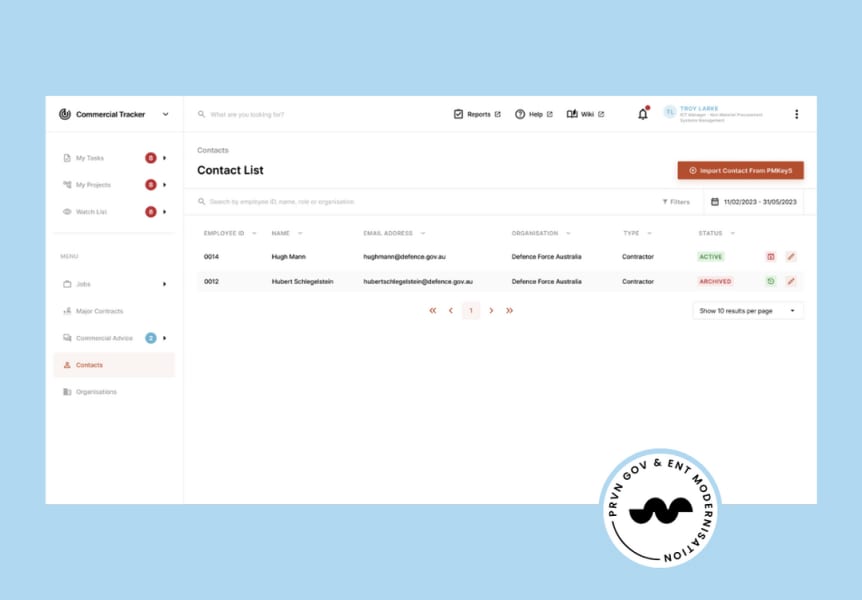Defence Leverages Sovereign Platform Engineering for Procurement Workflows
Commercial tracking team empowered through emerging model-based technology, delivering maintainability, data integrity, and reusability to escape the legacy software cycle.
The Department of Defence’s (Defence) My Procurement System (MPS) project stands as a testament to innovation within the public sector
and serves as an exemplar of how a government-focused ICT solution should be developed. Partnering with WorkingMouse, a sovereign small
to medium enterprise, this project has not only modernised the department’s procurement processes but also established new mechanisms for
the successful delivery of ICT projects within a blended environment of Australian public service, system integrators, and contractors.
In 2017, Defence was managing its Non-Materiel Procurement (NMP) workflow and tasking through more than 13 disparate systems (Excel,
Access, email accounts, etc.). WorkingMouse was engaged to consolidate these into a single application—the Commercial Tracker (CT). The
success of CT led to the continuation of their engagement and the initiation of the My Procurement System (MPS). Driven by the NMP
Branch’s willingness to innovate in the procurement digitalisation space and the lack of fit-for-purpose commercial off-the-shelf
options, they collaborated with Defence to realise a user-led procurement platform aligned with Defence procurement processes and tied to
federal government procurement policy. MPS went live in 2021, and the team continues to work with Defence to enhance the platform. MPS
was mandated for use across Defence by July 2024 and has already managed more than $8 billion in procurement as of Q1-2024/2025.
Context
In 2023, the team began modernising CT to realign it with MPS. Over the seven years since the initial development of CT, they have significantly enhanced their platform engineering capabilities, along with their expertise in people, processes, and tools. This case study demonstrates how these elements have formed a Federal Internal Development Platform that not only empowers the CT project with maintainability, data integrity, and improved project workflows for its stakeholders but is also reusable for Defence and other federal projects.
Tracker is a critical supplement to the My Procurement System (MPS), specifically managing material procurements for Defence. It supports procurement processes by tracking large-scale purchases and handling support requests, while ensuring security through ID generation and passcode management.
Initially built with older technology, Tracker became difficult to maintain, and its data integrity required improvement. The modernisation, driven by advancements in, the Model-based Platform Engineering Tool enhances the user experience, making the software more intuitive, visually appealing, and easier for new users to adopt.
As shown below, the user interface was functional but outdated and reliant on older frameworks:
![]()
Fig. 1 The legacy tracker User Interface
Action
In any project, three key variables play a crucial role in determining its success: people, process, and tools. These elements must work in harmony, balance with the project’s constraints, to ensure the best outcomes for the product, stakeholders, and end users. The combination of empowered people, a hybrid agile process, and paltfrom engineering tools not only drove the development of the solution but also provided the governance framework that ensured the project remained on track and aligned with Defence’s strategic goals.
People
The project team was structured using a Stream-aligned topology, comprising Defence’s subject matter experts and WorkingMouse’s cross functional Team (Project Manager, Designer, and Software Developer), supported by the Platform Engineering Team.
The Stream-aligned team was directly responsible for delivering features and enhancements based on Defence’s requirements. Empowered by the Platform Engineering Team, which provided the tools, frameworks, and platform-level support, the development team could focus on delivering value without being slowed by infrastructure concerns.
This structure allowed each group to bring their unique expertise, ensuring the solution was technically sound and aligned with Defence’s needs. Continuous feedback from Defence’s commercial tracking team guided the development process, keeping the project focused on user needs and facilitating quick decision-making.
Process
The modernisation of CT followed WorkingMouse’s Jidoka Process, known as “Automation with a Human Touch.” This methodology combines the flexibility of Agile frameworks with the structure of a traditional waterfall approach, all under a PRINCE2 project management framework. Inspired by the lean manufacturing principles of Jidoka, this process ensures a balanced integration of automation and human oversight.
A key feature of the Jidoka Process is its breadth-first approach, which prioritises developing each component within the context of the overall architecture. As components are built, they are continuously integrated into the Platform Engineering tools and models. This iterative development and integration cycle not only maintains project momentum but also ensures that the system becomes increasingly configurable and adaptable.
In the accompanying diagram, the breadth-first approach is illustrated through successive stages of development. Each stage, represented by different colors—purple, pink, and yellow—demonstrates how application coverage expands as components are built and referenced back into the model.
![]() Fig.
2 User interface model: Breadth-first application coverage.
Fig.
2 User interface model: Breadth-first application coverage.
By adopting this approach, the project effectively creates an Internal Development Platform, akin to a low-code solution. This platform not only enhances development quality but also ensures that the final product is scalable and adaptable to Defence’s evolving needs. Moreover, it maintains rigorous standards of maintainability and data integrity, crucial for long-term operational success.
Tools
The solution was delivered through a carefully orchestrated interaction between WorkingMouse’s cross-functional teams, the Platform Engineering team, and the robust set of tools they employed. Hosted on WorkingMouse’s ISO27001 accredited Private Cloud, these tools ensured a secure, efficient, and high-quality development process.
The Platform Engineering team empowered the WorkingMouse Cross-functional team with a suite of tools necessary to create the Application, Meta-Model, Models, and Pipelines. These tools were seamlessly integrated with tracker components, facilitating a smooth and collaborative development process.
In middle was GitLab, hosted securely within WorkingMouse’s Private Cloud. GitLab served as the central repository for both the application and its templates, acting as the single source of truth for all system knowledge. Within this environment, Continuous Integration and Continuous Deployment (CI/CD) pipelines were critical to the development process. These pipelines enabled the application to be released using Infrastructure as Code (IaC), ensuring that deployments were consistent, repeatable, and aligned with Defence’s quality requirements.
A major focus was placed on improving data structures and ensuring the security of sensitive information. This involved cleaning up existing data and implementing new security features, such as ID generation and passcode management, to maintain secure and reliable communications within Defence’s procurement processes. The CI/CD pipelines also played a vital role in enforcing these security measures, running comprehensive tests to ensure the integrity and security of data before each release.
Teams could work alongside the Platform Engineering code within their local environments, allowing them to customise niche application components as needed. This flexibility was crucial for adapting the application to specific requirements while maintaining overall system coherence.
Once developed, the tracker application was deployed onto Defence’s Restricted Network. Here, the Commercial Tracker Team provided feedback on the models, allowing for iterative improvements in the application’s functionality. This feedback loop not only facilitated continuous refinement but also balanced continuous improvement and sustainability, ensuring that the system remained adaptable and scalable over time.
Fig. 3 The Tracker toolset and team topology
This process created a highly maintainable system, capable of evolving with Defence’s needs while upholding the highest standards of quality and security. By leveraging the tools and methodologies provided by the Platform Engineering team, WorkingMouse was able to deliver a solution that was secure, sustainable, and tailored to Defence’s specific requirements.
Results
The Commercial Tracker (CT) solution provided the Defence NMP branch with unprecedented transparency in their procurement activities across the commercial support team. One of the key achievements of this modernisation was the digitisation of the Endorsement to Proceed (ETP) form. For the first time, Defence was able to consolidate, aggregate, and fully understand the quantum of procurement from a dollar value perspective. This transformation has not only streamlined the procurement process but has fundamentally changed how Defence approaches procurement.
WorkingMouse delivered the project on time and within budget, resulting in applications that have been internally recognised by the Department of Defence (DoD) with awards for innovation. The positive impact of the solution has been acknowledged at senior levels within Defence. Described by the previous First Assistant Secretary (FAS) as “the smartest thing I have ever seen in government procurement,” the system has significantly improved strategic and operational management, reduced duplication of effort, and freed up the commercial support team to focus on more value-added contracting activities.
The CT system also drives process and policy reforms by ensuring users engage with the appropriate number of vendors during the procurement process in real-time. It has been designed to integrate seamlessly with the One ERP Defence SAP project through secure APIs, ensuring long-term compatibility and efficiency.






.png)











